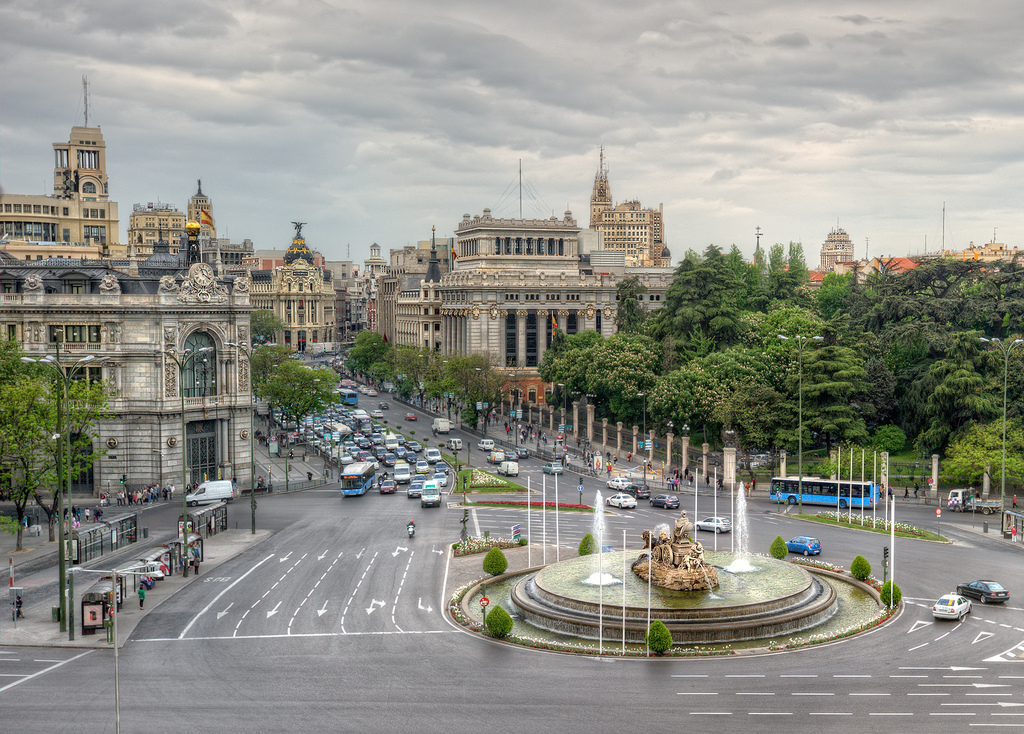Are you planning a trip to Madrid, Spain and are now in the process of preparing a daily itinerary for the course of your stay—coming up with a list of interesting things to do and see while visiting this beautiful and historically rich city? Have you yet to come across a place called the “Plaza de Cibeles,” a square that’s become an icon of sorts for Madrilenos (citizens of Madrid)? If not, the following information may prove very useful. Here we will provide a brief description of the Plaza de Cibeles, its location and unique characteristics, including some information on the historic buildings that occupy this impressive and one-of-a-kind city square.
The Plaza de Cibeles: Location and Characteristics
The Plaza de Cibeles is a popular city square in Madrid, located in the heart of the city and dissected by two major roads: Running north of the square is the Paseo del Prado, which turns into the Paseo de Recoletos, and running from east to west is the Calle Alcala.
The most significant features of the Plaza de Cibeles—and certainly the most impressive—are the Cibeles Fountain and the statue that presides over it. The statue depicts Cybele, the Greek goddess of fertility and nature, grasping a scepter and key, while being pulled by two lions on a chariot. The pull of these wild and majestic lions is said to represent the sheer power of nature and the goddess herself.
The Cybele statue was sculpted in 1782 by the artist Ventura Rodriguez, and its original location had it standing just outside the renowned Museo del Prado (Prado Museum), facing the fountain of Neptune. Legend has it the source of this original fountain actually goes back to a time when Madrid was a Moorish settlement, providing water to the local residents. The statue was ultimately moved to the Plaza de Cibeles in the 19th century, where it still stands today, allowing locals and visitors the unique opportunity to awe at its decorative details. For two centuries now, the Plaza de Cibeles has been an important meeting place and celebration locale for Madrilenos. Real Madrid, for example, Madrid’s local, successful and very popular football (soccer) club, has unofficially adopted the square, using it as a place to hold celebratory events whenever the team wins the Spanish League, Spanish Cup or other important event.
Plaza de Cibeles: Nearby Architecture
The Plaza de Cibeles is made up of four street corners, each of which plays host to an interesting and historic building:
Palacio Buenavista
The oldest of the four buildings on the Plaza de Cibeles is the Palacio Buenavista. This building was constructed back in 1777 and is currently the home of the Spanish Army’s headquarters.
Palacio de Linares
Built 100 years after the Palacio Buenavista, the Palacio de Linares is owned by the Casa de America organization—an organization that promotes political, economical and cultural cooperation with Latin America.
Banco de Espana
The Banco de Espana, or Bank of Spain, was erected in 1884 and serves as the headquarters of Spain’s central bank. The building has since been modified and added on to several times, mostly to increase its security.
Palacio de Comunicaciones
Began in 1912 and finalized in 1917, the Palacio de Comunicaciones has played host to Madrid city hall since 2007. The building was originally designed by Antoni Palacios as the headquarters of the Spanish postal service and was even home to the Postal and Telegraphic Museum up until 2002.



